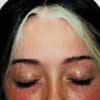Photoclinic: Piebaldism
A healthy 16-year-old girl was bothered by a patch of white hair on her forehead; she also had a few white plaques on her abdomen, which had been present since birth. Her maternal great grandmother and maternal grandfather, as well as her mother, had a similar pattern of white hair.

Ahealthy 16-year-old girl was bothered by a patch of white hair on her forehead; she also had a few white plaques on her abdomen, which had been present since birth. Her maternal great grandmother and maternal grandfather, as well as her mother, had a similar pattern of white hair.
Dr Sunita Puri of Decatur, Ala, diagnosed piebaldism, or partial albinism, an autosomal dominant congenital disorder. This stable, fairly rare condition affects persons of all races and both sexes equally. About 90% of patients with classic piebaldism have a white forelock that emanates from a midline, symmetrical, triangular, elongated, or diamond-shaped white macule. The medial eyebrows and the eyelashes may be involved.
Vitiligo-like amelanotic macules--which can contain some normally pigmented cells--may be found on the trunk and portions of the extremities; however, the dorsal spine, hands, feet, and perioral area are spared. The macules are sharply demarcated from normally pigmented skin and result either from incomplete migration of melanoblasts from the neural crest to the ventral midline or from a defect in differentiation of ventral melanoblasts to melanocytes.
Piebaldism needs to be distinguished from the progressive, rarely congenital disease vitiligo and from Waardenburg syndrome, which features the white forelock as well as displacement of the inner canthi and lacrimal puncta, prominent nasal root and medial eyebrows, congenital deafness, heterochromic irides, and hypomelanotic macules. Piebaldism with deafness is known as Woolf syndrome.
Cosmetics and dyes may help mask the physical signs of this disorder. Autologous minigrafts may be tried. Advise patients to use sunscreens.
Recognize & Refer: Hemangiomas in pediatrics
July 17th 2019Contemporary Pediatrics sits down exclusively with Sheila Fallon Friedlander, MD, a professor dermatology and pediatrics, to discuss the one key condition for which she believes community pediatricians should be especially aware-hemangiomas.